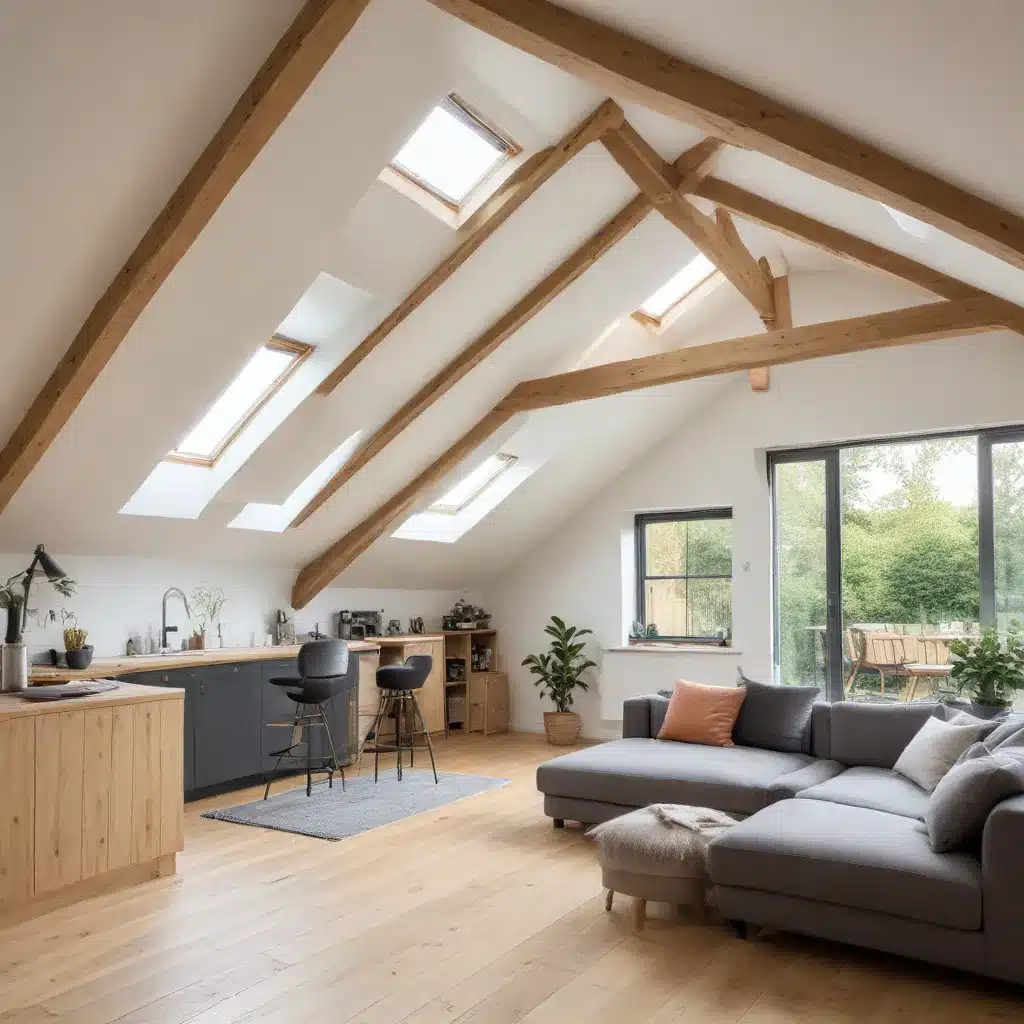
Unlocking the Potential of Your Loft Space with Sustainable Solutions
As a seasoned construction professional and interior designer, I’ve witnessed the rise of loft conversions as a popular trend, especially in space-constrained London. However, the true potential of these transformative projects lies in embracing sustainable design principles that not only enhance the aesthetic appeal of your new living space but also minimize its environmental impact.
In this comprehensive article, we’ll explore the world of sustainable loft conversions, delving into practical tips, innovative design ideas, and expert insights that will inspire you to create an eco-friendly sanctuary in your home.
Bringing the Outdoors In: Harnessing Natural Light and Ventilation
One of the cornerstones of sustainable loft design is the seamless integration of natural elements. By strategically placing skylights, large windows, and well-positioned openings, you can maximize the influx of natural light, reducing the need for artificial lighting and creating a bright, airy atmosphere.
“Incorporating ample natural light not only brightens up the space but also helps to reduce energy consumption and carbon footprint,” explains Steph Fanizza, an Architectural Design & Team Manager at Extension Architecture. “Careful planning and sun studies can ensure that your loft conversion harnesses the power of the sun while maintaining comfortable indoor temperatures.”
Beyond daylighting, sustainable loft design also focuses on natural ventilation. By incorporating passive cooling systems, such as strategically placed vents and openings, you can effectively regulate the temperature of your loft space without relying heavily on energy-intensive air conditioning.
Biophilic Design: Bringing Nature Indoors
Sustainable loft design goes beyond just harnessing natural light and air; it also embraces the principles of biophilic design, which aim to integrate natural elements and organic forms into the built environment.
“Incorporating plants, green walls, and other greenery into your loft conversion can not only enhance the visual appeal but also improve indoor air quality,” says Daniel Lindahl, a fellow architect. “This connection to nature can have a profound impact on the mental and physical well-being of the occupants.”
By strategically placing potted plants, creating mini indoor gardens, or even incorporating living walls, you can transform your loft into a serene, nature-inspired oasis that promotes a sense of calm and connection to the great outdoors.
Sustainable Materials: Embracing Eco-Friendly Choices
The selection of building materials plays a crucial role in the sustainability of your loft conversion. From reclaimed wood and bamboo flooring to recycled glass and natural fibers, there are countless eco-friendly options that can help reduce your carbon footprint without compromising on style.
“When it comes to sustainable loft design, we encourage our clients to consider the entire life cycle of the materials they choose,” advises Eugene Kim, Founder and Managing Director of Extension Architecture. “By opting for renewable, durable, and low-embodied energy materials, we can create beautiful spaces that are also environmentally responsible.”
Embracing sustainable materials not only supports the local economy and reduces waste but also contributes to the overall well-being of the occupants by minimizing the use of harmful chemicals and toxins.
Ground Floor Extensions: Expanding Sustainably
For those looking to enhance their living space beyond the loft, ground floor extensions offer an alternative approach to sustainable design. By expanding the home’s footprint horizontally, you can create a seamless transition between indoor and outdoor living areas, leveraging the benefits of natural light, ventilation, and integration with the surrounding landscape.
“Ground floor extensions allow for a more holistic approach to sustainable design,” explains Mick Pearce, an Architectural Designer known for his biomimicry-inspired projects. “By incorporating features like energy-efficient glazing, passive cooling systems, and biophilic elements, you can create a truly eco-friendly living environment that enhances both your quality of life and your home’s environmental impact.”
Harnessing the Power of Biomimicry
Biomimicry, the practice of emulating nature’s time-tested strategies to solve human design challenges, is a fascinating approach that has gained traction in the realm of sustainable architecture.
“By looking to the natural world for inspiration, we can develop innovative, energy-efficient solutions for our loft conversions and ground floor extensions,” says Janine Benyus, author of the seminal book “Biomimicry: Innovation Inspired by Nature.”
One prime example of biomimicry in action is the Eastgate Centre in Zimbabwe, which takes inspiration from the passive cooling system of termite mounds to regulate the building’s temperature. Similarly, the Eden Project in Cornwall utilizes a geodesic dome design inspired by the structure of soap bubbles to maximize sunlight exposure and natural ventilation.
Embracing the Future of Sustainable Loft Design
As we navigate the ever-evolving landscape of sustainable living, the future of loft conversions promises to be both eco-friendly and aesthetically captivating. By incorporating the principles of natural light, ventilation, biophilic design, sustainable materials, and biomimicry, we can transform underutilized loft spaces into true sanctuaries that respect both our personal well-being and the well-being of our planet.
“Sustainable loft design is not just a trend; it’s a fundamental shift in the way we approach home renovation and construction,” concludes Steph Fanizza. “By embracing these innovative solutions, we can create living spaces that are not only beautiful but also contribute to a more sustainable future for all.”
So, whether you’re planning a loft conversion or a ground floor extension, consider the power of sustainable design to elevate your living experience and leave a positive impact on the environment. The future of home renovation is green, and the possibilities are endless.
Ready to embark on your sustainable loft conversion journey? Contact the team at Local Builder London to explore the endless possibilities of eco-friendly design.


